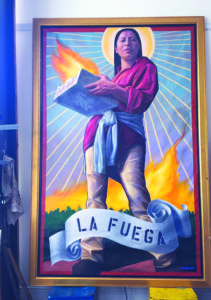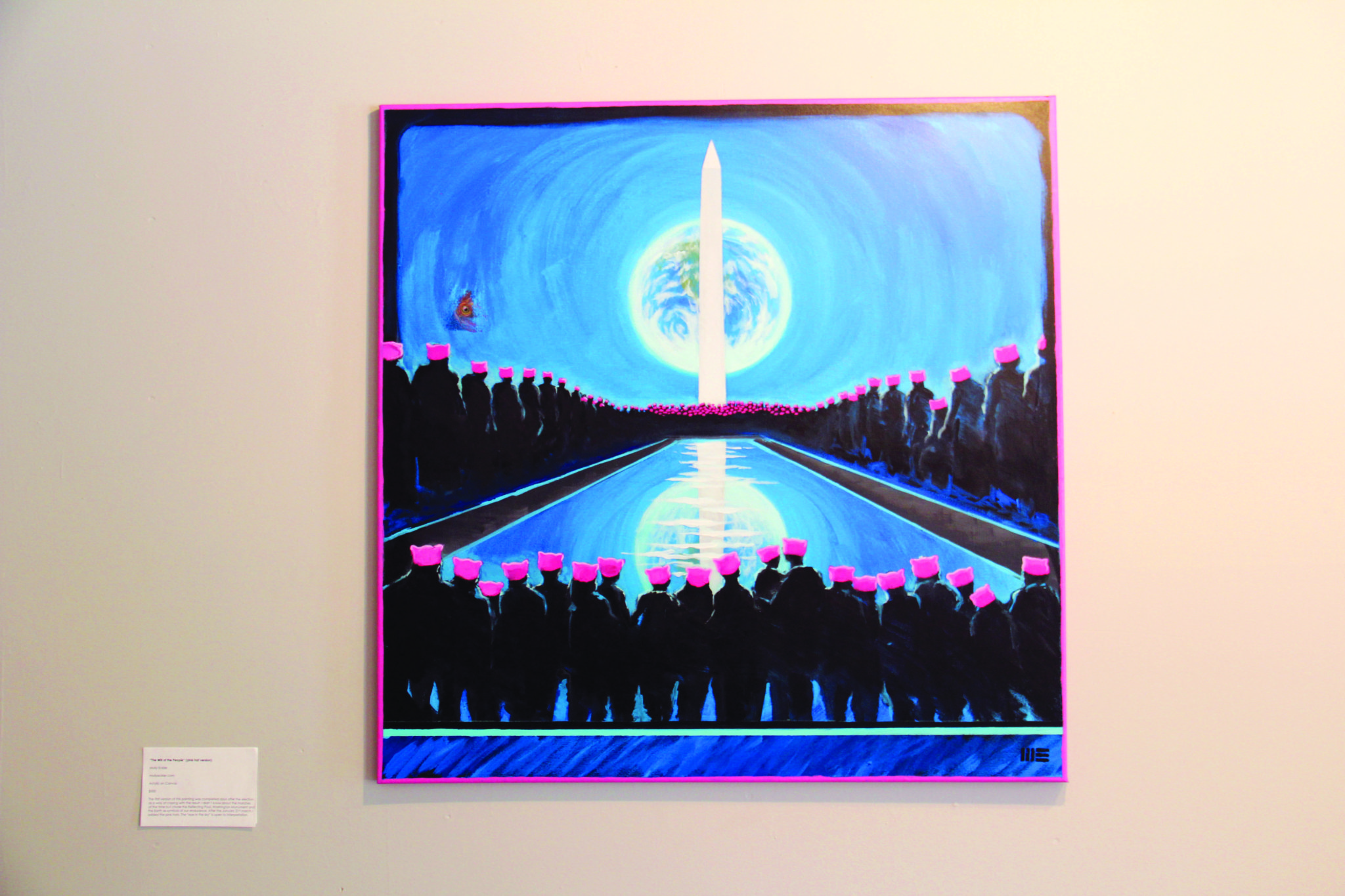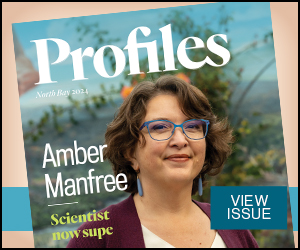By David Templeton
“Art and poetry have long played a role in social and political discourse. Artists and poets help identify personal meanings and promote individual expression of diverse ideas. Moreover, art and poetry often tap into deeper and more symbolic aspects of our relationship to sociocultural and political events.
… Let the artists and poets speak their truth.”
—Patrick Gannon, Adrienne Amundsen, April 20, 2017
It’s just after noon on a warm Saturday at the end of May, and the first of dozens of art pieces has already been removed and carried away by its creator. Lone wall tags—bearing the titles and artists of the absent pieces—only make the few empty spaces more noticeable. These are the final hours of “Against TRUMPISM: The Art & Poetry of Resistance,” an engaging and (occasionally) quite polarizing art show tucked into a pair of rooms at San Rafael’s Museum of International Propaganda.
With hours to go until the exhibit must be down, there are still plenty of pieces on display, bearing an array of identifiable images combined in provocative and poetic ways: American flags, the Statue of Liberty, shooting range targets, pinky pussy hats, feminine hygiene products, monsters, post-apocalyptic rubble and of course, the face of sitting President Donald J. Trump.
Scattered throughout the images are an abundance of keynote words. Frequently appearing are “Democracy,” “Bully,” “Evil,” “Fascism,” “Horror,” “Sick,” “Angry,” “Fake,” “Female,” “Pussy,” “Fight,” “Freedom,” “Immigrant,” “American,” “Christ,” “Cash” and “Heartbreak.”
On one wall is a small, dark painting, with faint, barely visible words of hopelessness and despair, with one word standing out in bright glowing pink: “Hope.” The piece, titled “(Art is) the Last Hope of a Hopeless Nation,” is by teenager Jasper Sanchez, identified on the painting’s wall tag as “a queer Jewish transgender American.”
As a small but steady stream of weekend visitors step through the door, their eyes wide with surprise that such a thing as a Museum of Propaganda exists (and in Marin County), Patrick Gannon—an artist, therapist and curator of the “Against TRUMPISM” show—warmly greets the occasional contributing artist stopping in to pick up art.
“Did you see this one?” asks Gannon, pointing to Sanchez’s piece. “The title is so full of desperation and depression. But hope is not lost. It’s still emerging from this sea of darkness.”
The piece points to one of Gannon’s primary observations about political art: That it frequently springs from a deeply personal place, from feelings as much as from thoughts. To that end, Gannon says that he’s begun working with other mental health professionals seeking to better serve their clients, and to take some kind of positive action in the wake of November’s election.
“When Trump was elected, and then leading up to the inauguration, people were getting more and more upset,” Gannon points out. “A lot of it was sheer speculation based on how we viewed him during the campaign, and how we saw that as impacting him as president. And then, during the lead-up to the inauguration—and of course, the Muslim ban he imposed shortly afterwards, [he] rapidly became a galvanizing influence that sparked different kinds of mobilization across the country.
“And a whole lot of artists got really activated all over the nation,” he continues. “All at once, they started producing political art. In my opinion, personal expression about a political issue is ‘political art,’ while propaganda is art that is designed to mobilize, to influence, to persuade and to depict issues or people in a particularly specific way.”
Some art, of course, straddles both of those definitions.
“Of course it does,” Gannon acknowledges. “Art is messy. It doesn’t follow other people’s definitions. It ignites, and it burns. And it does burn through and across simple definitions.”
That said, those definitions can still be useful. There are plenty of artists who strenuously avoid any hint of having created propaganda, steering their artistic efforts more toward honest personal expression. And there are those who clearly hope that their art will mobilize others into political action by striking a chord with like-minded individuals. But whether it falls on one side or the other, there’s no denying that political expression in art is on the rise.
“In the wake of Trump taking office, you now see all these pop-up art shows happening all over the country,” Gannon says. “There are all these resistance groups forming, and often enough, in the weeds of one area’s resistance movement, there pop-up these kinds of art shows. This is one. The “Nasty Women” show in New York was one. There was a political art show in Santa Rosa last month, too. It’s a movement that’s happening within the artistic communities of the country. Amateurs, professionals, they’re all being activated to express themselves in really powerful ways.”
This, of course—with very few exceptions—is not the kind of art that will end up hanging in a gallery. It’s not generally intended to be eternal. Much of it is, in fact, expected to flare up, burn hot, spread its flame, and then fade, burning to ashes the rage, fear and despair that first sparked it into existence. Some resistance art is created more for the benefit of the artist than for any impact it might have on others.
“I’m not really a political artist, actually,” says Cat Kaufman, whose piece titled “Democracy Machine” represents her first foray into political art. “I made this because I felt I had to do something, just to feel better after the election.”
“Democracy Machine” is, in fact, a machine, somewhat resembling a hanging lamp, with gears and mechanisms conspicuously at work. It’s actually lit from within—with an LED bulb illuminating a lengthy quote from John Adams that begins, “A Free government is a complicated piece of machinery.” Beyond the outer skin of the piece, the faint shadow of a beating heart can be seen deep inside it.
“I liked the idea of making a machine that was sort of broken and falling apart, but whose heart was still beating, down deep inside,” Kaufman says. “It’s the first piece of art I really felt I just had to do. I’ve been trying—with a little help from my wife—to get past all of the emotions I’ve been feeling. I’ve had so much anger building up in me. I built this piece in January, when I felt like I needed to somehow calm down. Honestly, the idea of making more of this, of putting more anger into my art, I just don’t want to do that. So right now, I don’t plan on making any more political art. It’s just not good for me emotionally.”
That said, Kaufman says she recognizes that the art project sometimes chooses the artist.
“I think we’ve got the greatest smoke-and-mirror president we’ve ever had,” she says, carefully beginning to


dismantle “Democracy Machine” to take back to her studio. “And I am so alarmed by him, but I can only do what I can do. I march in the marches, and I write letters and sign petitions. But sometimes I still feel so helpless. And sometimes, creating a piece of art is the only thing that helps me feel better.”
Kaufman’s revelation brings up an important question about resistance art. Is political art just a form of self-medication? Or can artistic expression actually change the course of the future—even just a little?
“Art is how I digest what’s going on around me, but as an artist who does social justice-inspired art, I do want to change the world,” says Priscilla Otani, whose piece, “She Bleeds Garnets and Rubies (A Tribute to Megyn Kelly),” is one of the most notably provocative—and stunningly beautiful—pieces of art in the show. It’s a mixed-media triptych, described on a wall tag as, “The Holy Trinity of Megyn Kelly’s menstrual blood, transformed into sacred jewels by Trump’s petulant curse, ‘You could see there was blood coming out of her … wherever.’”
“The process of creating art out of politics is something I challenge myself to do, because I think it’s important,” Otani says. “Right now I’m creating a very large piece, a handmade book called ‘The First One-Hundred Days.’ I’m building it out of Braille texts, to emphasize how blind Trump is. I have to admit, some days I feel pretty icky, working on this so deeply. But it’s such fertile ground.”
Resistance art, Otani says, is about inspiring others to go deeper into their own feelings, by provoking those feelings through seeing and reacting to a particularly strong or powerful piece of artwork.
Otani’s point leads to another major element of most resistance art. When it’s functioning effectively, people do have strong reactions to it. But it shouldn’t end there.
“Good political art should make us want to talk to each other,” says New York artist Lily White, creator of the piece titled “Winning Personality,” a striking collage built upon a shooting range target. The assemblage is one of several such pieces she’s made in a series she calls “Targets.”
“I do believe the purpose of art is to allow the artist to work through and express their own emotions and confusions and questions and uncertainties, but there’s more to it after that. It’s all well and good to have our feelings, and to make art to express those feelings, but if that’s all that happens, is it really enough? The next step is to engage with other people who have different feelings.”
That isn’t always an easy process, though, White allows.
“We’ve lost the ability to talk to each other civilly,” she says. “We used to teach debating in school, but now, no one knows how to have a conversation about issues we disagree on. They’ve forgotten how to seek out common ground. It’s all about beating down the other person like an opponent, rather than approaching them as a fellow human being, and using words to find some kind of common ground.”
Can art do that? Can it pave the way to common ground?
“I think it can, especially when we do it side-by-side, like when we all used to do art projects in class, in school,” White goes on. “When everyone is expressing themselves through art, and everyone looks at what the others are doing, I think it makes an impact. We learn about each other, and we learn to accept differences.
“I do believe that art can change the world,” she adds. “I’m a romantic that way. But I do believe. But you have to be doing more than just expressing yourself. You have to be listening to others, too. If the world is going to progress, we all have to change, and I believe that art—political art, resistance art—can be part of how we can change together.”
White’s view, compared to many political artists, reflects a remarkable degree of hope. In a time of despair and fear, when liberties and freedom actually are being rolled back, an expression of hope can seem a bold and transgressive act, which is, perhaps, part of what young Sanchez is saying with his “Hope” piece.
After Otani has removed her pieces from the gallery, and several works have also been taken down or dismantled, Sanchez’s piece still remains. In a show where images have been proven to have enormous impact, perhaps one of the most moving pieces of resistance art is the statement Sanchez makes on his own small wall tag.
“In the aftermath of the election,” he writes, “when I felt dejected and despondent about my future as a queer Jewish transgender American, I found my lifeline in words. I wrote until I didn’t feel afraid anymore. I reminded myself that there’s always hope, so long as we bear our souls along with our teeth. So let this be your reminder: Go forth; create; send up a flare in a dark and swirling world.”













It happens more frequently than we want to admit. Someone aces the interview and despite a resume or work history that doesn’t quite fit, you go ahead and make the hire.
Immediately, you notice that something is not exactly right. What seemed a strength during the interview becomes a liability once the job begins. Your gut begins to wrench, but you disregard the feeling and reassure yourself that in time it will work out.
The truth is that those situations seldom get better. Bad hires are bad hires. While an analysis of where you got it wrong is intellectually an attractive exercise, the reality is that at the moment it doesn’t matter. The best and, usually only, course of action is to cut the losses immediately. I say “usually” because once in a great while the new hire comes to same conclusion and makes the first move, admitting that the new position is not working out for either party.
And so we have Donald Trump.
Whether you agree with his politics or find him a deplorable, being President of the United States is a bad fit for him and for us. The “probationary” period is over. The Constitution , the way the country needs to be governed and his personal style do not mesh. Not now and not ever. The republic is built on a foundation of principles that are not easily changed. His leadership style is built on a dynamic that will not change.
No one need take the blame; no one need accuse the other. It is a bad fit and both parties need to move on. The country with a new leader and Trump back to what he does best outside of the government.
Continuing the pattern of accusations and recriminations is the absolutely wrong course. Admitting that it’s time to hit the reset button is much preferable to the rabbit hole that we are collectively populating.
fedupwithdonaldtrump.com